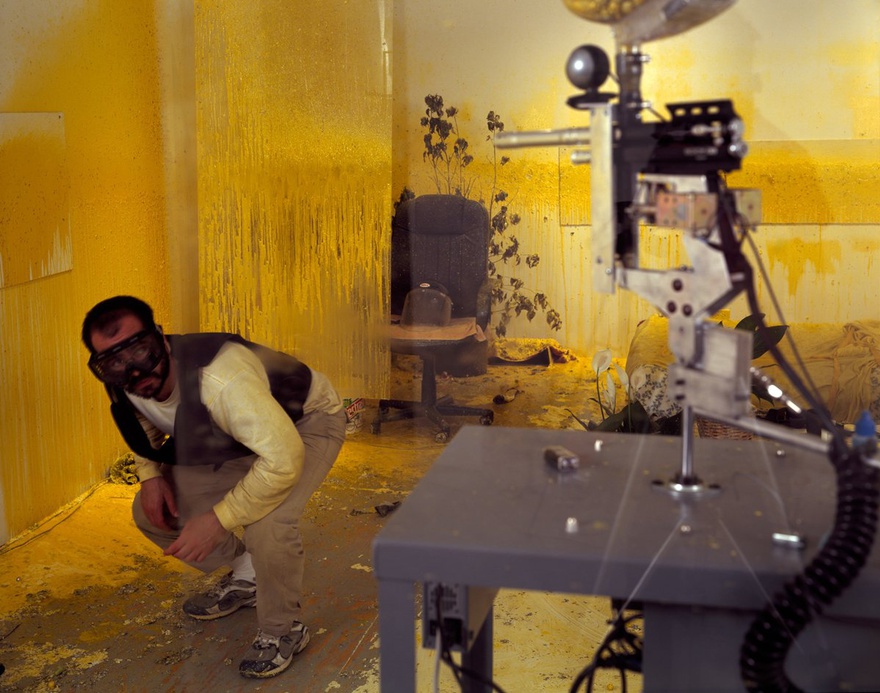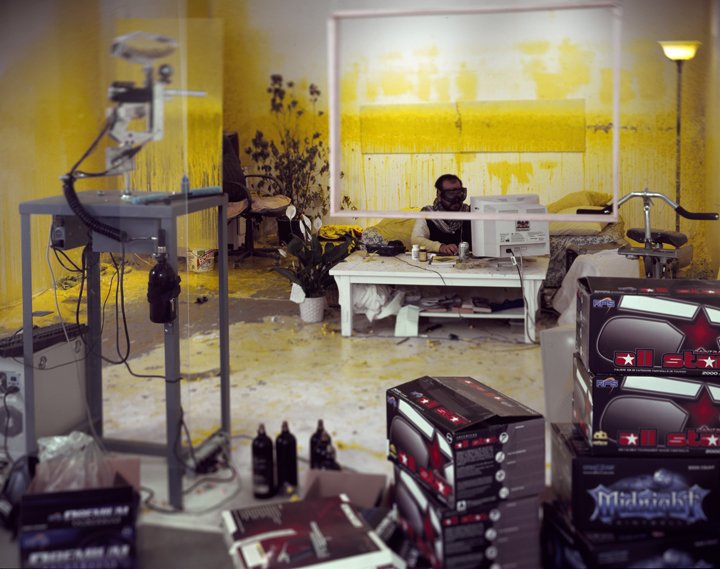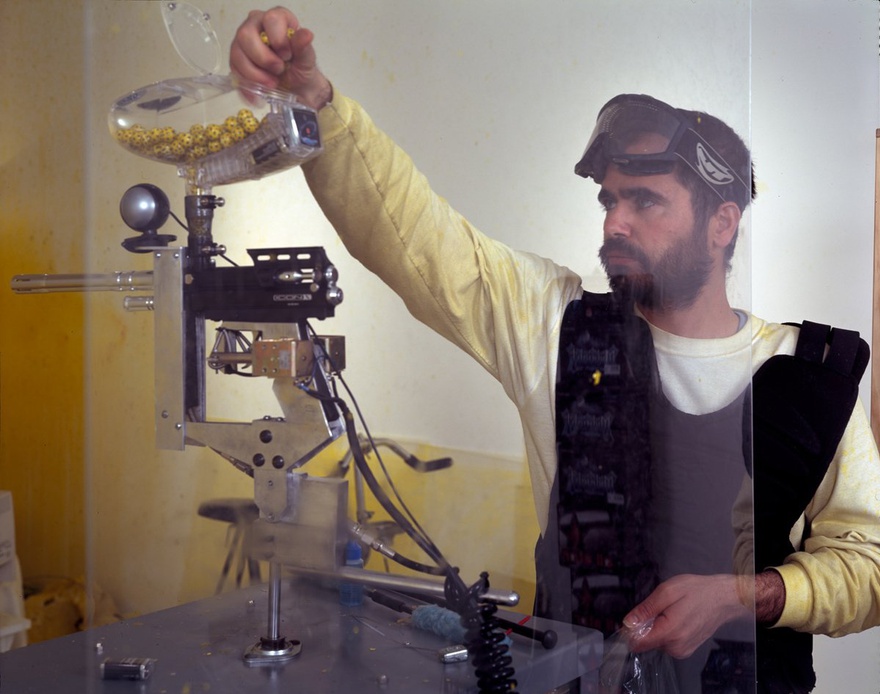Publications
A Prologue to the Past and Present State of Things
Looking at Wafaa Bilal's Domestic Tension: Barrak Alzaid
Can performance effect systemic change within society? What tools does performance provide to complicate, disrupt, problematize, revise and interrogate dominant systems and structures of power and control? In 2004 Iraqi artist Wafaa Bilal received news that his brother was killed by an American military drone and channelled this devastating loss into a work titled Domestic Tension (2007).[1] What was initially conceived as an interactive installation became a worldwide phenomenon that centred around the public's complicity with the violence and technologies of war and their accompanying traumatic effects. To fully comprehend the work, individuals were invited to relate to the broader conflict in Iraq within and through Bilal's personal experience of violence.
When visitors entered Chicago's FlatFile gallery in the spring of 2007 to view Wafaa Bilal's Domestic Tension, they faced an assault of noisome fumes from viscous yellow paintballs that covered every surface, as a barrage of shots thudded dully against their ears. In this work, the artist lived alone for one month in a prison-cell sized room in the gallery, directly in the line of fire of a remote-controlled paintball gun. A camera mounted to the top of the gun connected the artist to internet viewers around the world who could shoot at him 24 hours a day through an online interface that included a control panel to direct the gun.[2] As the project went on, a virtual audience grew by the thousands: the online interface became a crucial aspect of the live performance and played host to 80,000 users from 128 countries who fired 60,000 shots over the course of 31 days. A chat area allowed online visitors to speak to other users and the artist. Bilal also produced daily YouTube updates, which can still be streamed today.
Through various layers of enactment, Domestic Tension represented a highly political move to interrogate complacency by the United States in the face of the ongoing effects of the Iraq War. The work confronts the spectator's capacity to witness violence and trauma as a staunchly ethical dilemma. In his book on the project, Shoot an Iraqi, Bilal recalls that there were distinct divisions among viewers: some were aggressive shooters, others were curious bystanders and some actively engaged in protecting Bilal from the shots. 'I want the project to force each viewer to confront their own motives, their own internal conflict about shooting me,' Bilal wrote.[3] In this, the viewer became a primary agent in control of the violence perpetrated on the artist, just like the soldiers directing drone planes over Iraq. The dynamics of participation were complex. Shooters were able to direct the gun but also had to compete with others for control. At one point, Bilal recounts, shooters discovered they could fire many shots at once by opening up multiple browser windows. 'They're loving it,' he wrote, 'someone in Milwaukee opens 19 browsers and starts firing away; he tells me he's giving me a 19-gun salute.'[4] Viewers treated the interface like a video game in which actions have no consequences; such excessive gestures underscored the symbolic power of violence as a vehicle for pleasure, which takes over from all other forms of receptivity as the performer gives up his subjective experience to the viewer-as-participant. This capacity to both view and interact compounds the user's complicity with the violence of Domestic Tension, underscoring the user's inability to recognize the suffering they were subjecting upon Bilal. This element of violence constructs a dynamic between the audience and the artist that goes beyond viewer and subject. What this essay argues is that the highly charged content of Domestic Tension as a performance and as testimony demands that the viewer also bear witness to the subject matter at hand.
In his YouTube videos, Bilal communicated his daily responses to the piece and updated viewers on his state of mind. As the piece progressed, the emotional and physical strain brought out prior experiences of the first Gulf War and the 2003 US-led intervention in Iraq. We learn from several of these videos that the performance is a direct response to the deaths of his brother and father at the hands of remote artillery fire. Bilal shares these intimate portraits and politicizes them through his testimonies as they have been drawn from his experience of the performance. Narrativizing trauma becomes a form of truth-telling in this respect. For professor and psychoanalyst Dori Laub, whose work focuses on the traumatic legacies associated with mass genocide and the Holocaust, testimony is something that arises out of an exchange between a speaker and listener: co-participants who, through their dialogic engagement and affective exchanges, constitute the testimony of the traumatic event.[5] However, Bilal's performance troubles this notion of testimony as a linear exchange and expands the ways in which violence within a traumatic event can be narrated and expressed. The camera stands in for the live witness and directly engages thousands of individuals who track Bilal's experience online. Such viewers are constituted as co-creators of the traumatic narrative by the very act of their witnessing, regardless of whether they point and click the gun at the artist.
There is an aspect of witnessing in Domestic Tension that introduces a strategic state of looking that potentially allows for violence to carry on unattended. Users consent to shooting the gun at Bilal, while others gaze on from their comfort zones on the other side of their monitor. Such inaction fulfils the violent mandate of the project as much as the active participants shooting the gun. The dual components of video diary and chat are part of the ethical strategy of the piece. For spectators, the question is not as simple as 'shoot' or 'don't shoot' since they must address their own position in relation to the artist's suffering. They must come to know how they are implicated in the violence through the very technology that constitutes the violence – in other words, the remote user interface. In an interview describing the inspiration for his set up Bilal reflects:
Only when I watched an interview with an American soldier who was sitting in Colorado, directing these drone planes and dropping bombs on people in Iraq, did I realize that she was completely disconnected psychologically and physically from his [sic] targets.[6]
The technology employed by soldiers reinforced the distance between the aggressor and the targets and calcified an intense form of looking that is in fact 'not looking'. The soldier views schematics, information, coordinates, maps and satellite images but is unable to see the cost to humanity and what is at stake in her own participation.
This form of looking destroys insight and thwarts the spectator's ability to identify with the subjects of violence, as they are simultaneously unable to recognize their role in the scenario and are incapacitated from intervening. In her 2005 book Disappearing Acts, scholar Diana Taylor terms this mode of 'not looking' percepticide, to remind us of the way national identity is shaped through the spectacle of violent acts and spectatorship. She does this by analysing the political spectacles that comprised Argentina's 'Dirty War' between 1976 and 1983, particularly the disappearances of innocent civilians. She claims that during this time, in order to qualify as 'good' Argentineans, people were forced to ignore the atrocities. Even as people denied what they saw, individuals in public places continued to be picked up by men in military attire and disappeared. People literally turned away from their fellow citizens and for Taylor this 'was the trap that destroyed community cohesion'.[7] A vital and performative series of protests that attempted to recuperate this loss were the marches by the Madres de la Plaza de Mayo which began in 1977 and continued through to 2006. The Madres paraded photographs of their sons and daughters as a way to resist the silencing by the regime and increase the visibility associated with their disappearance. In a similar fashion Domestic Tension draws attention to the effects that an inability to bear witness has on both the viewers and the artist. Bilal achieves this by enacting a visibility campaign of his own, using the reactions of the masses to unveil the dynamics we are really dealing with when it comes to violence and our perception or experience of it.
The context of Domestic Tension – the 2003 US invasion in Iraq – reflects two aspects of this passive spectatorship. An unprecedented number of embedded journalists presented direct footage of the war front, which provided an illusion of an 'inside view'. This belied the massive collateral damage to homes and Iraqi civilians created by the 'shock and awe' strategy in Iraq that included 29,200 air strikes beginning in March 2003.[8] Although people throughout the world watched the live reporting, they were far removed from the extensive damage that impacted civilians and which continue to shape the lives of people affected by US military aggression. In his project, Bilal uses his own identity as an Iraqi to connect the spectator to violent acts as well as the broader issues of the Iraq war. He foregrounds his identity and becomes the necessary subject of the violence.[9] In this light, the notion of percepticide and Taylor's recounting of the Madres' resistance to it helps us to understand the other layer of violence in Bilal's performance that occurs by silent spectators viewing the onslaught. Theirs is a tacit acknowledgement that allows the violence to recur in an unmediated fashion, halting only when the server overloads from too much traffic or when the gun runs out of paintballs and cannot be refilled quickly enough. When violence is constituted in this way – in the manner of a passive spectatorship – it becomes systemic: rooted in structures of power.
To account for a reconfigured viewing experience within this context, we must look at how a particular form of empathic witnessing was produced through Domestic Tension. In Diana Taylor's methodological approach towards problematizing the empathy of seeing in Argentina's 'Dirty War', she writes: 'I'm attempting to make space for an involved, informed, caring yet critical form of spectatorship which, for lack of a better term, I'll call witnessing'.[10] This form of witnessing ties together the experiences of the witness and the witnessed event in an active, affective set of relations. Not only does the witness see the violence but, in order to bear witness to it, must engage with it critically and literally care for the subject of violence. This form of witnessing consequently operates as a relational and ethical mode of engaging with others that surpasses the limitations set by the regime and society's maintenance of it through percepticide.
Domestic Tension was a scenario constructed as an open invitation for spectators to create a performance in collaboration with an artist to explore violence and the limitations of passive witnessing and remaining silent; both forms of witnessing that merely sustain violence. The spectator is aware of the conditions of violence, as well as their implicated position with respect to it, but does not act – a mode of looking that can be traced back to the first Gulf War in 1991, during which live broadcast via satellite technology transformed war reporting into a daily event of dramatic storytelling.[11] This legacy persists in the hypermediated world Bilal's work creates, heightening the awareness of our complicity with violence so as to induce empathetic witnessing. In his project, Bilal reveals that only by engaging with people on a 'human level' can they shift their perceptions and alter their actions. In his book recounting the experience he relates an exchange with a woman from the UK:
She kept saying, 'KILL KILL KILL MAIM KILL.' Then, 'Yr a handsome bloke! Don't b coy.' I wanted to cut through the ridiculous banter and talk to her as a normal human being. Finally, when I told her about my brother's and father's deaths I was able to engage her in real conversation. One of them said she was sorry for my losses and years of exile […] 'Shootin seemed really fun at the time. We all feel really bad now!'[12]
How is it possible to move so abruptly from a call for violent dismemberment to feeling sympathy for the artist? It is not until Bilal discloses his own pain and suffering beyond the physical experience that viewers can empathize with him. In this affective revelation viewers do not simply identify with the artist but also feel shame for celebrating the artist's suffering. That such a perceptual change can occur in an individual almost instantaneously points directly to the power of performance as a potential model for changing broader human relations.
What is effectively seen in this empathic view of Bilal's project is not merely 'the narrative of extreme human pain,' which Dori Laub describes as the primary form of bearing witness.[13] Empathic witnessing demands both tactile and visual modes of engagement and marks a way into the ethical relationality of violence. That is to say, bearing witness entails a form of self-reflexivity in which the viewer confronts her own complicity with that violence and, in so doing, effectively bears witness to ultimately tap into the broader politics of the project. In this, Domestic Tension offers a model for empathic witnessing in which seeing, touching and feeling are knitted together in vital relation to the event.
On an individual level, a single woman stopped firing while many others continued shooting. Days later, on Memorial Day weekend, Beverly Wilson, an art student Bilal had never met, discovered that by constantly clicking left, she could ensure that the gun listed away from Bilal as long as her clicks outnumbered the shooters aiming at their target. Wilson drew up a schedule to cover Bilal continuously over the course of several days and formed a 'virtual human shield' with dozens of others around the world.[14] Bilal also notes that Wilson logged the most hours and even visited his gallery to bring him food and fresh socks. Wilson not only participated in a form of virtual political activism, she extended that work into the real world to produce material changes in Bilal's existence. The collective actions of the group she mobilized on the one hand denounce the efforts of aggressors to shoot at another human being and, on the other, actually prevent any shots from being fired. The viewing experience transforms from one of virtual engagement to an embodied witnessing of the event. This represents the next stage of empathic witnessing which engages the site of violence in a material way. The individual viewing experience, through the camera lens and the multi-user platform of the online performance site, becomes a collective and transformative viewing experience.
Speaking on the potential for virtual communities to engender social change, Leah Lievrouw, Professor of Information Studies at UCLA, offers an understanding of online affiliative networks as 'digital technologies to share information and interact with widely dispersed, like-minded others outside of traditional institutional or organizational structures. As such, these affiliative forms may help foster new spaces for civil society or the encouragement of social capital.'[15] Tapping into these networks through Bilal's performance site situates violence as a productive force and not merely one rooted in destruction. Change is possible through the use of digital technologies, which become a framework to alter the material conditions that allow violence to occur.
This awareness of our ability to affect and be affected by each other destabilizes the very notion of a stable comfort zone by offering a potentially transformative politics. We may all see the same thing when we turn on the news, flip open a smart phone or log on to the Internet. However, bearing witness through the empathic gaze demands that we do not simply participate as an interpretive community that sees violence but instead negotiate our own relationship to the violence. Domestic Tension is not merely about rendering the impact of violence visible but revealing the mechanisms to transform the conditions that produce violence. This politics is one that turns looking into action by complicating the act of bearing witness as one comprised simultaneously of seeing an event, participating in it, feeling its effects and taking action. In order to bear witness to violence, the witness must first locate herself in relation to the violence. This furthermore renders visual the mechanisms of violence and has the potential to mobilize individuals in order to halt it.
[1] Shelley Rice, on Domestic Tension: An Interview with Wafaa Bilal by Shelley Rice,' Jeu de Paume website, http://lemagazine.jeudepaume.org/blogs/shelleyrice/2012/10/01/domestic-tension-an-interview-with-wafaa-bilal-by-shelley-rice/
[2] Ibid.
[3] Wafaa Bilal and Kari Lydersen, Shoot an Iraqi: Art, Life and Resistance Under the Gun (San Fransisco: City Lights, 2008), p.143.
[4] Bilal and Lyderson, op. cit., p.58.
[5] See: Dori Laub, 'Bearing Witness or the Vicissitudes of Listening' in Testimony: Crises of Witnessing in Literature, Psychoanalysis, and History, Shoshana Felman and Dori Laub, M.D., eds. (New York: Routledge, 1992).
[6] Rice, op. cit.
[7] Ibid., p.122.
[8] Lt. Gen. T. Michael Moseley, 'Operation IRAQI FREEDOM - By The Numbers,' Global Security website, http://www.globalsecurity.org/military/library/report/2003/uscentaf_oif_report_30apr2003.pdf.
[9] See: Les Roberts et al, 'Mortality before and after the 2003 invasion of Iraq: cluster sample survey,' The Lancet, 29 October 2004, http://www.cs.princeton.edu/~chazelle/politics/bib/lancet.pdf; Gilbert Burnah et al., 'Mortality after the 2003 invasion of Iraq: a cross-sectional cluster sample survey,' The Lancet, 12 October 2006, http://www.jhsph.edu/research/centers-and-institutes/center-for-refugee-and-disaster-response/publications_tools/publications/additional_pdfs/Burnham_2006-Iraq2_Lancet.pdf; and Jim Krane, 'US Precision Weapons Not Foolproof,' Associated Press Archive, 1 April 2003, http://www.apnewsarchive.com/2003/U-S-Precision-Weapons-Not-Foolproof/id-3530fc41ad349adb3a8dce9e57a23246.
[10]> Diana Taylor, Disappearing Acts: Spectacles of Gender and Nationalism in Argentina's 'Dirty War' (Durham and London: Duke University Press, 1997), p.25.
[11] 'Television – The Persian gulf war,' American Foreign Relations website, http://www.americanforeignrelations.com/O-W/Television-The-persian-gulf-war.html#b%23ixzz1uKXkqB1I.
[12] Bilal and Lyderson, op. cit., p.112.
[13] Laub, op. cit., p.57.
[14] Bilal and Lyderson, op. cit., p.142.
[15] Leah Lievrouw, 'When Users Push Back: Oppositional New Media and Community' in Communities and Technologies: Proceedings of the First International Conference on Communities and Technologies, M. Huysman and V. Wulf, eds.(Dordrecht: Kluwer Academic Publishers, 2003), p.400.













